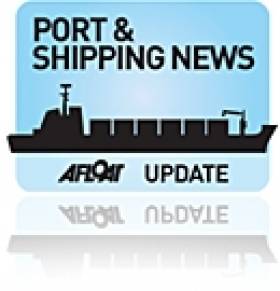Displaying items by tag: HNLMS Mercuur
Ports & Shipping Review. Cargoships, WFSVs, Cork Ferry, IMERC, Dutch Navy & Last H&W Ferry Sold
#PORTS & SHIPPING REVIEW - Over the last fortnight Jehan Ashmore reports from the shipping scene which saw a 'Pop-Up Village' delivered by cargoship to Galway Port in readiness for the Volvo Ocean Race festival which started yesterday and continues to 8 July.
Arklow Marine Services second wind-farm support vessel (WFSV) Gardian 10 was launched for UK owners and today the vessel travelled from Arklow to Belfast Port and berthed at the Abercorn Basin.
In the rebel county, efforts to revive the Cork-Swansea route took a new step when a group was formed to ascess the feasibility in re-launching the Celtic Sea link that closed last November after Fastnet Line went into examinership.
At the Taoiseach's Public Service Excellence Awards, the Irish Maritime Energy Research Centre (IMERC) based in Haulbowline, Cork Harbour, won an award which was presented by Minister for Justice Alan Shatter T.D. at a ceremony held in Dublin Castle.
Across the world the International Maritime Organisation (IMO) highlighted the Day of the Seafarer on 25 June, where the role of those who work on ships provide a vital service in transporting essential goods on a global scale to meet our needs on a daily basis.
Dublin Port welcomed a flotilla from the Royal Netherlands Navy this weekend, where two of the vessels including a torpedo-training ship HNMLS Mercuur (A 900) was open to the public.
Today the cruiseship Saga Sapphire made her maiden 'Irish' port of call to Cobh having entered service in March for UK based operator Saga Cruises. The 706-passenger capacity ship is due to dock at Dublin Port tomorrow morning.
Former North Channel ferry stalwart Stena Caledonia which operated on the Larne/Belfast-Stranraer routes since 1990 has been sold by Stena Line to ASDP Ferry of Indonesia. She is the last ever passenger ship to have been built by Harland & Wolff shipyard in Belfast.
Dutch Naval Flotilla Head for Dublin Port Visit
#DUTCH NAVAL VISIT – A torpedo training ship HNLMS Mercuur (A 900) is one of four vessels of the Royal Netherlands Navy based in Den Helder which are scheduled to visit Dublin Port next weekend, writes Jehan Ashmore.
During the four-day call, the HNLMS Mercuur and the Alkmaar class minehunter HNLMS Vlaardingen (M 863) will be open to the public on the Saturday and Sunday between 2pm-4pm. All the vessels will be berthed alongside Sir John Rogersons Quay.
HNLMS Mercuur is fitted with a maintenance shed for torpedoes and as a target ship for submarines to fire dummy torpedoes. She has an armament of 1 underwater launch tube for Mk. 48 torpedoes. The 64.8m vessel has a crew of 39 and the vessel which displaces 1,400 tonnes is powered by a 2 x MAN 6L-20/27 diesels (1,632 hp total) which deliver 14 knots.
The 41.5m long navy training ship (MOV) Van Kinsbergen (A902) is used for practical nautical training, a task for which it was specifically built and equipped. In addition to the navigation bridge, the MOV Van Kinsbergen has a second, fully equipped training bridge. There are five-crew and also the same number of civilian crew.
A second Alkmaar class vessel HNLMS Zierikzee (M862) forms the final member of the flotilla. Each of the 51.5m long vessels which weigh 534 tonnes has a crew ranging between 28-38 personnel. The Alkmaar class origin is a joint design of the Netherlands, Belgium and France navies.
The Dutch constructed the propulsion system, the Belgiums provided the electronics and the French built the mine-hunting equipment. To reflect the cooperation between the three countries, the international name of this class of ship, are referred as the Tripartite class.

























































